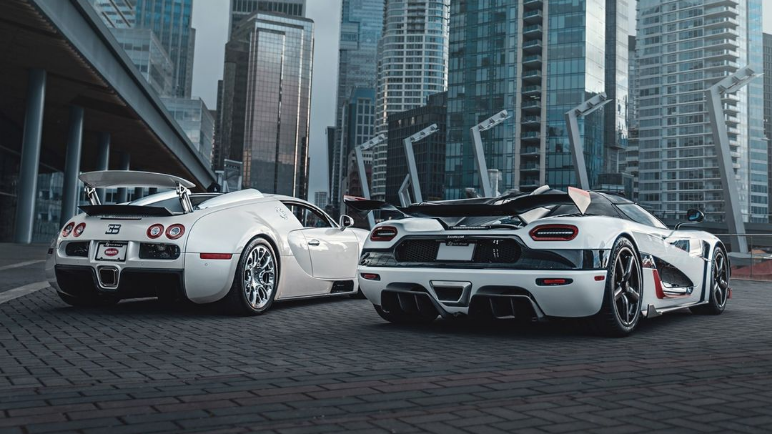

Passing the mythical 500 km/h mark is not just a question of speed. It is a challenge that involves the most advanced engineering, the most sophisticated aerodynamics and a detailed understanding of the physical forces that are exerted at these mechanical altitudes. For two decades, a handful of manufacturers have been competing on this extreme terrain: Bugatti, Koenigsegg, SSC, and more recently the Chinese giant BYD with its Yangwang division.
.jpg)
The record has long been held by the Bugatti Chiron Super Sport 300+, which reached 490.484 km/h in 2019 on the Ehra-Lessien track. An achievement that will remain in everyone's memories, especially as Bugatti chose not to approve the attempt in a “back and forth” configuration as required by the FIA. For its part, SSC announced 455 km/h with its Tuatara (after a controversial first attempt at over 500 km/h). Koenigsegg clocked 447 km/h with the Agera RS in 2017, an officially validated record. Finally, in 2025, BYD Yangwang hit hard with its U9 hypercar, credited with a top speed of 496 km/h, a sign that China intends to rise to the top of this very exclusive competition.

But why is crossing 500 km/h so complex? The answer lies in the laws of physics. Aerodynamic resistance, which increases with the square of the speed, becomes gigantic. At 500 km/h, nearly 1,800 horsepower are needed simply to beat the air, not to mention mechanical losses. The car must cut through the wind with extreme precision: every air intake, every curve influences stability. This is why the hypercars launched in this quest display streamlined silhouettes worthy of prototype aircraft.

Tires are another colossal obstacle. At these speeds, they have to withstand phenomenal centrifugal force. Michelin, a historic partner of Bugatti, has designed tires capable of withstanding a wheel rotating at more than 5,000 rpm, the equivalent of nearly 490 km/h. At this rate, each square centimeter of rubber takes on several tons of force. The smallest defect, the smallest air bubble in the structure, and that's the immediate explosion. These tests are carried out on special benches developed with... NASA.

This challenge is similar to that of other extreme terrestrial machines. American rocket vehicles, such as the Thrust SSC, which broke the sound barrier in 1997 at 1,227 km/h, benefit from rigid aluminum tires and turbojet propulsion. In contrast, American dragsters, equipped with supercharged engines exceeding 10,000 horsepower, literally twist their rear tires under the effect of power. But these cars only reach their crazy speed over a few hundred meters, not over several kilometers like a road hypercar.

Bugatti, true to its pioneer image, is already preparing for the sequel. Its new Tourbillon, presented in 2024, has more than 1,800 horsepower thanks to its naturally aspirated V16 combined with mild hybridization. Officially limited to 445 km/h for safety reasons, its graduated speedometer up to 550 km/h suggests the theoretical potential. Everything indicates that Bugatti is preparing a new assault on the legendary bar, with the stated objective: to finally cross the 500 km/h border.

In fact, this race is not just a battle of numbers. It is a tug of war between man and the laws of physics, a way of pushing the boundaries of what is possible even further. Reaching 500 km/h means entering a dimension where every detail counts, where the smallest air molecule becomes an adversary, and where the automobile joins the aeronautical field.
Does destiny exist? A vast, almost philosophical question that engineers and Maserati enthusiasts would unhesitatingly answer in the affirmative. Founded in 1914 in Bologna by the Maserati family, the brand went from a simple mechanical workshop working on Isotta-Fraschini to a real competition department in a few years. In 1926, the Type 26 was born, the first homemade creation and the first to feature the Trident inspired by the Neptune Fountain in Bologna.
There is always that little hesitation when preparing for a trip. The desire to take your exceptional car, to enjoy every kilometer, to make the road an integral part of the experience... and, at the same time, the constraints. The logistics, the risks, the uncertainty of arriving serene. Too often, we give up, leaving our car where it is, sheltered but immobile. This is exactly where Carsup is changing the situation. Travelling in your car should never be a cause for concern, but a simple and smooth pleasure.
There have been pivotal years in Formula 1. Seasons where you feel that something is changing, where certainties waver, where engineering is getting the better of habit. 2026 is one of those seasons. Regulations are changing, cars are being transformed, engines are entering a new hybrid era, and even the grid is welcoming new faces. Cadillac is coming. Audi is getting ready. F1 is about to write a chapter where anything is possible again. And that is undoubtedly what enthusiasts were waiting for: a discipline that reinvents its own future.
Didn't find the answer you were looking for?
Contact us, and an expert will respond promptly.